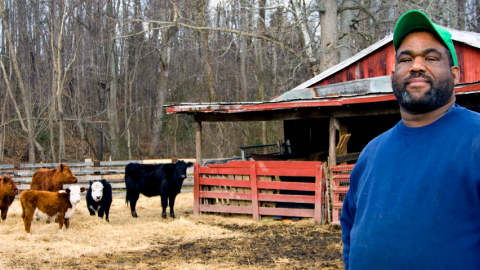ERS provides economic research and analysis of issues related to agriculture, food, the environment, and rural America. For information about how to access USDA programs and services please see USDA's Farmers.gov website. Beginning farmers, including women and veterans, can find additional information on USDA's Beginning Farmers and Ranchers website.
Beginning Farmers and Ranchers
A beginning farmer is someone who has materially and substantially participated in the operation of any farm or ranch for 10 years or less. For statistical purposes, USDA, Economic Research Service (ERS) defines a beginning farm as one on which all operators are beginning farmers. Some USDA programs—such as beginning farm operator education programs—are available to beginning farmers even if there are more experienced operators who also work on the farm. Other USDA programs only provide benefits or services to beginning farmers if all farm enterprise operators are beginning farmers.
According to the 2016 Agricultural Resource Management Survey, almost 17 percent of the approximately 2 million family farms were beginning farms (See "Characteristics of principal farm operator households, by experience of operators, 2016" in the Farm Household Income and Characteristics data product). Beginning farms were smaller, on average, than more established farms; in 2016 they produced about 10 percent of the total value of farm output.
Beginning farm principal operators tend to be younger, with an average age of 49.1 compared to 61.9 for established farm principal operators. In 2016, more than a third of beginning farm principal operators (36.2 percent) had a 4-four year college degree or higher, compared to 26.8 percent of established farm principal operators. While beginning farm households earned less income from the farm, they earned more from off-farm activities than established farm households and had a higher average total household income ($131,176 compared to $115,274 in 2016).
Limited-Resource Farm Households
Limited-resource farm households are defined as having low farm sales and low household income for 2 years in a row. In fiscal year 2020, low farm sales meant direct or indirect gross farms sales not more than $180,300. Low household income means that current-year income falls below the national poverty level for a family of four with two children, or is less than half of the county median household income.
About 7 percent of principal operator farm households were classified as being in the limited-resource classification in 2016 (see the table "Characteristics of principal farm operator households, by limited-resource farm status, 2016" in the Farm Household Income and Characteristics data product). Limited resource farms on average are smaller than other farms (having an average of 209 acres versus 411 acres). Principal operators of limited resource farms are also older (average principal operator age was 65 versus 59 for other farms) and more often indicated they were not in the paid workforce, suggesting they may be retired. On average, limited resource farms lost money farming on a cash basis (losing $11,890) compared to positive farm income for non-limited resource farms ($27,527).
Female Farmers and Ranchers
Female principal operators accounted for 13 percent of farms in 2016 (see the table "Characteristics of principal farm operator households, by sex of principal operator, 2016" in the Farm Household Income and Characteristics data product).
Women were principal (having primary responsibility for the day-to-day operation of the farm) operators of about 256,000 farms in 2016. An additional 565,000 female operators contributed to operating farms as second or third operators. Second and third operators provide added focus on farm business management relative to production management skills that the principal operator possesses. Female principal operators were older on average than their male counterparts (61.6 years versus 59.5 years). About 40 percent of women principal operators were 65 or older in 2016. Additionally, 28 percent of female operators reported that they were not currently in the paid workforce.
Women were over-represented as a share of principal operators on beginning farms and limited resource farms. Women were principal operators of 19 percent of beginning farms, versus 11 percent of established farms. Women were principal operators of 27 percent of limited resource farms compared with 11.5 percent of non-limited resource farms.



